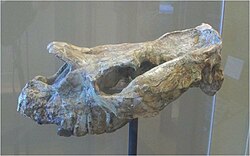| Leontiniidae | |
|---|---|
 | |
| Leontinia gaudryi | |
| Scientific classification | |
| Domain: | Eukaryota |
| Kingdom: | Animalia |
| Phylum: | Chordata |
| Class: | Mammalia |
| Order: | † Notoungulata |
| Clade: | † Eutoxodontia |
| Family: | † Leontiniidae Ameghino, 1895 |
| Genera [1] | |
| |
Leontiniidae is an extinct family comprising eighteen genera of notoungulate mammals known from the Middle Eocene (Mustersan) to Late Miocene (Huayquerian) of South America.







